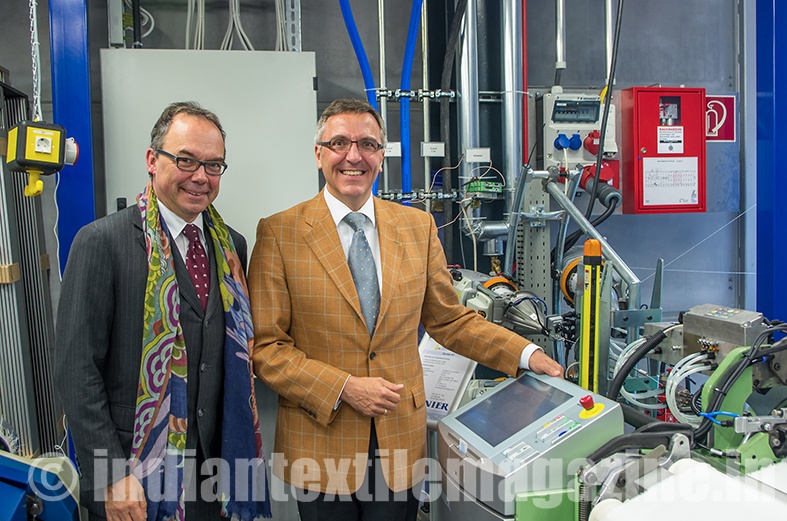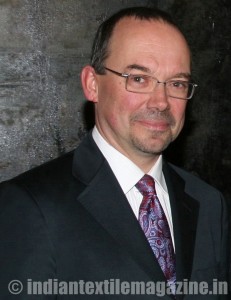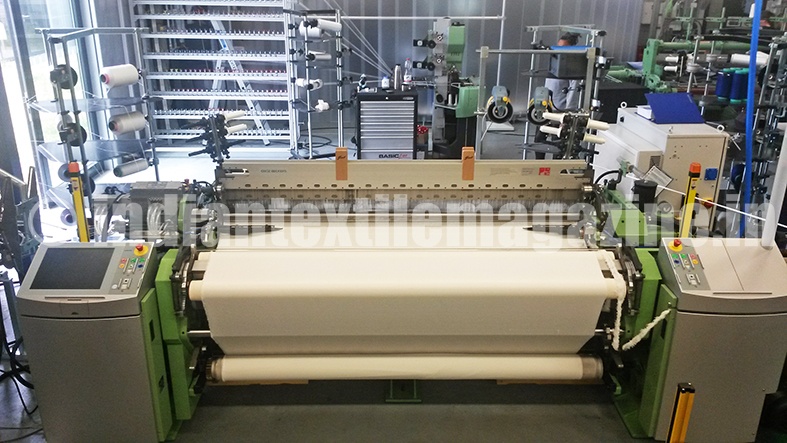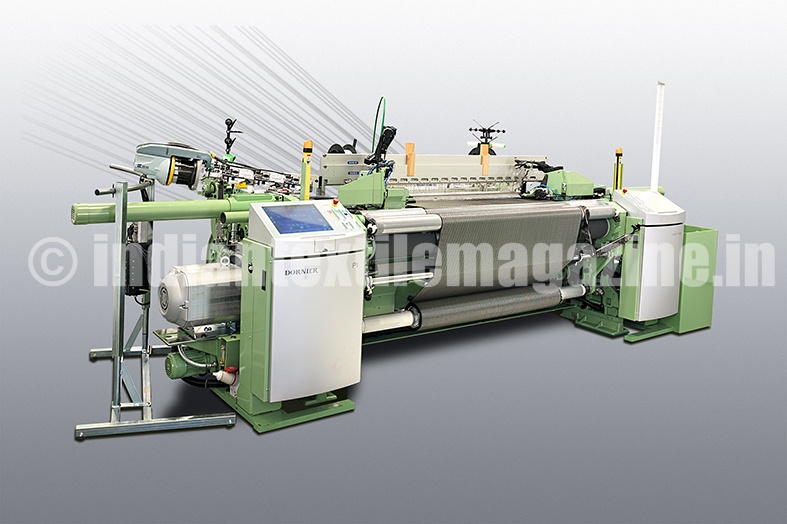Weaving is one of the oldest manufacturing processes known to man, but in the age of technical textiles it is about to undergo exciting new transformations, says Peter D. Dornier, Chief Executive Officer and co-owner of Lindauer DORNIER GmbH. An active member of VDMA, his company is a world market and technology leader in building weaving machines. Almost 60 per cent of all woven carbon and aramid fabrics, 50 per cent of all glass fibre fabrics, two out of every three airbags and three out of four motor vehicle tyres worldwide are woven on machines built beside Lake Constance.
“Wovens have exciting potential as inherently digital structures”, he says in an exhaustive interview.
Excerpts:
The name of Dornier has been synonymous with the pioneering spirit for almost a century, like a unifying theme running through the history of our company: The “Dornier Spirit”, the unceasing pursuit of technical advance. Even when he was working for Count Zeppelin, my grandfather, aircraft designer Claude Dornier, was imbued with this spirit. My father, the founder of Lindauer DORNIER GmbH, inherited it from him, and it remains a hallmark of our enterprise to this day. Accordingly, our maxim for new developments has always been and will always be “Use the best technology to offer the maximum customer benefit”.
To name just a few of the latest milestones: Very recently, we created the label “DORNIER Composite Systems”. This has enabled us to combine our expertise in constructing weaving machines and film stretching machines for a more efficient process for manufacturing high performance composites from film and fibres. Or our “The Green Machine” concept, with the twin objectives of producing exceptionally high-performance woven products for protecting people and the environment, while maximising resource conservation. This sustainability has been a part of the corporate DNA of Lindauer DORNIER GmbH ever since it was founded, and not just because our weaving machines have been the same colour green for the last 50 years.
Was sustainability also evident at ITMA in Milan?
Yes. Regarding “The Green Machine” for example, we unveiled an item that surpasses everything for which we are known in terms of technology. Our green weaving machines are already widely respected as the “benchmark” for environmental and personal protection, but we intend to expand their application spectrum significantly. For example, I am thinking of a market like China which accounts for a quarter of our sales at the moment. Among many other items, DORNIER machines are used there to produce filter fabrics for – desperately needed – pollution control in water and air. Incidentally, our “green” machine concept is derived from the basic idea of the VDMA Blue Competence initiative for optimising machines or processes, that is to say reducing energy and air consumption will improving performance.

Dedicated to science: Peter D. Dornier (right) handing over an A1 air-jet weaving machine to ITA director Prof. Dr. Thomas Gries
But with regard to sustainability, DORNIER goes yet another step further, because our weaving machines and film stretching systems typically have service lives lasting 30 to 40 years. These are certainly not “disposable products”. And one or our strengths is that we provide support with spare parts and service for as long as this makes financial sense for our customers. This is also what “The Green Machine” means to us.
A question about the innovation process: Where do your ideas come from?
One of our great advantages is that we are active in more areas than all of the other weaving machine builders. Our customer base covers, for example, wire weavers making ultrafine filter fabrics for turbochargers or metal printer cartridge fabrics, carbon fibre weavers making cables as thick as your finger on Jacquard looms, and Italian clothing manufacturers producing soft, lightweight suit material with our air jet weaving machines. Not a few new ideas are inspired by transfer, that is to say from the markets or straight from our customers themselves. For example, when a known feature is applied to new application fields, truly surprising positive solutions are created – as in the case of our low-mass back beam, which was developed especially for weaving aramid fibres for antiballistic applications: an Italian wool weaver wanted to know whether this innovation could also be used successfully with wool. It was because of precisely this question that this back beam has now become standard for weaving wool on our machines. Another source of innovations is also our co-operation with a small number of European market, quality and technology leaders and the like from the aerospace industry.
Weaving has been a part of human life for 6,000 years now. Are there any new challenges and opportunities for this textile technology to face these days?
Most definitely. Weaving, the appeal of which is based precisely on the consistency of the materials produced, is practised these days in an astounding range of variations: From the very finest “flat” filtration meshes for blood or printing ink to the thick, heavy 3D multilayer fabrics used to reinforce conveyor belts. Even the Internet giant Google has recently taken an interest in weaving and joined with the clothing manufacturer Levi’s to found the “Google-Jacquard” label. The object of this is to convert items of clothing into input devices for smartphones and other mobile devices.
It is known that Joseph-Marie Jacquard replaced the chains for preset patterns with punched cards on looms, and so invented the first digitally controlled machine as long ago as 1805. But a woven fabric is always “intrinsically” digital anyway, the weft passes either over or under the warp. This means that in the weaving mill we have the only truly, purely digital manufacturing process. All other machines produce analogue structures, including those that are controlled digitally. We are currently standing on the threshold of a completely new departure, in which we can produce wovens that are structured not only in two but also in three dimensions and with reproducible “digital quality” as it were. Weaving as an intrinsically digital process has enormous potential, and we are only slowly beginning to realise what the future might bring, especially with regard to mass production.
What trends are emerging?
In future, we will undoubtedly be able to replace even more metals with plastics than ever before, or enhance the performance of metals or ceramics with textile reinforcement. If we want to become more mobile, but still be more lightweight, efficient and economical in terms of CO2, composites with carbon, glass or aramid fibres will be the only way ahead. And thermoplastics like PA, PP and HT polyester will become very important, particularly in terms of sheer quantity. For instance, the possible benefits of fibre-reinforced plastics in terms of safety are vast, and so far we have not even scratched the surface of the applications and implications of this for mass-produced motor vehicles.
The age of metal in the aerospace industry is already on the decline, and in hindsight will be nothing more than an intermezzo, also because of the issues surrounding CO2. My grandfather managed to fly his first aircraft made entirely of metal in 1916, at about the same time as Hugo Junkers. The material he used, aluminium, was the material of choice in this application field for just 80 years. Today, textile composite materials account for half the weight of modern aircraft, for the Airbus A350 it is over 50 per cent, and for the Eurofighter 82 per cent. However, in most cases unidirectional (UD) textiles are currently used.
What I mean to say is this: It is precisely woven materials for which demand will increase in industrial applications. A woven mass production part is digital, and can be manufactured with total reproducibility in a well-established production process. Just a quick glance at other textile technologies for comparison purposes: For weaving car airbags, that is to say in the field of safety-critical components, a single technician oversees 40 DORNIER weaving machines. In a large fabric facility operated by a car maker to produce structural components from carbon, these figures are practically reversed. This example shows what the weaving process has to offer in terms of globally distributable, industrial efficiency. The world’s leading airbag or tyre manufacturers already benefit from this every day, while large sections of the metal industry are still barely aware of what is coming.
This just goes to show that textiles are making a comeback, but in an entirely different form, in aircraft, in cars, in wind turbines or even as the coating material on the boots of professional football players. Woven textiles, the standards and qualities of which can be reproduced almost identically anywhere in the world, are becoming more and more indispensable.
Have you have maintained contacts with several textile research institutes for many years?
We have worked together with institutes like the TITV Greiz, which formulate the basic foundation of smart textiles, for a long time, in order to implant electrical or circuit functions in the Jacquard technology, for example. For me personally, creating 3D structures with this technology is immensely exciting. And we have strategic partnerships with the Institute for Textile Engineering (ITA) at the Rheinisch-Westfälische Technische Hochschule in Aachen and the Institute for Textile Machinery and Textile High Performance Materials Engineering (ITM) at Dresden University of Technology.
In order to support the training of future textile engineers and ongoing research projects in Aachen, for example, Lindauer DORNIER GmbH recently sponsored an ultramodern A1 type air-jet weaving machine. But the co-operation is not a one-way street: For instance, the ITA can use this extremely powerful machine to advance the digitisation of manufacturing equipment as part of the larger Industry 4.0 initiative, and we have already acquired the services of two doctoral students graduating from the ITA.
Your company is known the world over. Are there actually any new markets for you?
From a geographical point of view, we could call them new, old markets, if I look towards Russia and Iran. Both countries have an investment backlog that stretches back over 30 years, and they want German engineering because “Made in Germany” means efficiency, reliability and a long service life. In Iran, for example, 5,000 DORNIER weaving machines shipped in the 1970s are still in service today. Not much has been replaced in our sector since that time. Or consider Russia and India: Both countries are making more and more intensive use of technical textiles to develop their infrastructures, and some of their ideas are quite ingenious.
Such as?
A relatively large Russian enterprise has just been awarded a world patent for the manufacturing process for a product that is also interesting for Canada: huge saddlebags for weighing down and anchoring gas pipelines in the ground as the permafrost becomes increasingly marshy. These enormous pouches are filled with excavated earth or rocks and are made from woven HT polyester produced on our machines.
As a technology leader in weaving and special machines for producing ultrafine plastic films, eight percent of the personnel at Lindauer DORNIER GmbH are employed in Research and Design Engineering, which is a relatively high proportion. 114 of about 960 staff are directly involved in the innovation process. Founded in 1950, the company is now under the leadership of the second generation of the same family, and in 2014 it reported turnover of 256 million euro. The company exports over 90 percent of its products.
DORNIER weaving machines are used to produce fabrics for airbags, carbon fabrics for composite structures and aramid wovens for flame-retardant or bullet-proof applications, to name but a few. Even so, machines from the DORNIER system family are also ideal for weaving ultrafine silk fabrics, complex Jacquard items or fine worsteds. DORNIER systems for precision film products are used both for products for the packing industry and for such high-tech applications as semiconductors, capacitors for hybrid motor vehicles, or foil displays in mobile phones and flatscreen monitors.
Sharing the site of Friedrichshafen airport, the Dornier Museum commemorates 100 years in the history of air and space travel, including textile technologies for new, high-tech materials.
“We are currently standing on the threshold of a completely new departure, in which wovens can produce not only in two dimensions but also with structuring in three dimensions and with reproducible ‘digital quality’ as it were.”
– Mr. Peter D. Dornier, Chief Executive Officer, Lindauer DORNIER GmbH


